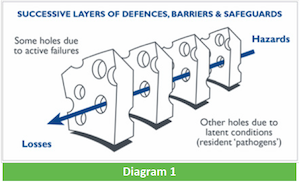 If we look at organisational accidents, in some ways they are completely random in the way that the contributing factors come together to achieve adverse outcomes. It is very rare that two accidents are exactly the same. There’s always something different, generally, even if it is only the victim that is different.
If we look at organisational accidents, in some ways they are completely random in the way that the contributing factors come together to achieve adverse outcomes. It is very rare that two accidents are exactly the same. There’s always something different, generally, even if it is only the victim that is different.
But the circumstances that led up to the event are often different.
However what generally is the same, is a whole series of underlying precursors, that always seem to point in the same direction, with tiring consistency, that makes you wonder, why do we even bother? We’re repeating exactly the same things over and over and over again and no one seems to learn.
These underlying precursors are the organisational conditions, that if you can identify and correct, you have a higher probability of reducing the chance that those accidents will occur.
Think of an accident where somebody slipped on the floor and you basically said, “you should be more careful in the future”.
We need to look at the underlying causes, because if we do not find them, the whole concept of accident prevention is pure fantasy.
You cannot control random events. The whole concept of random events is that they cannot be predicted. It’s like saying I have a wonderful system for telling you how to win Tattslotto. By definition, if it’s a true fair system of picking numbers out of a hat, it is random, you cannot say how it is going to work. What you can do, is some predictive algorithms that will say there is a higher probability of certain numbers occurring.
So we’re really trying to say, how can we make accident prevention a science as distinct from faith or hope?
A considerable proportion of the work we will reference in this series is based on Prof James Reason’s model of accident causation and human error, relating to intention, planning and outcomes of actions.
The basic model that Reason uses is a very simple one. You have some hazards in place, whatever this means; it could be flammable materials, it could be people stressed because of time frames, lack of resources, it could be asbestos, it could be noise, it could be whatever from the whole range of hazards. And generally organisations have some defences in place. We have hearing protection, we have supervision, we have training, we have procedures, etc, etc.
Every now and then these defences fail and you end up with some sort of loss. This is a very basic and simple model. See Diagram 1.
Safety is something generally very difficult to sell to management, and in Part 2 we’ll explain why.
Beyond Ordinary Part 2: Organisational Accidents
Reasons adapted diagram taken from Toft, Y., Dell, G., Klockner, K., Hutton, A. (2012). Models of Causation: Safety. In HaSPA (Health and Safety Professionals Alliance), The Core Body of Knowledge for Generalist OHS Professionals. Tullamarine, VIC. Safety Institute of Australia.





